The February 20th Movement is the public and youthful face of the Arab spring in Morocco, emerging on that date into the streets as part of a series of coordinated Sunday demonstrations throughout the country. One of its rallying slogans is dastarat tawsi’at hay’at al-insaf wa-al-musalaha, or “’constitutionalize” the recommendations of the Equity and Reconciliation Commission (ERC).” The ERC, more commonly known by its French initials IER, “Instance Equité et Reconciliation,” is a state-mandated body to investigate cases of torture, forcible disappearances, political prison, locations of mass graves, and to make judgments about individual and communal reparations. It was established in December 2004 by royal decree and headed by Driss Benzekri, a former political prisoner, in order to address human rights abuses during Morocco’s long and dark decades known as the “years of lead.” Although the competence of the commission was non-judicial, its range covered the years 1956 from Morocco’s independence from France until 1999, the year of the death of King Hassan II and the ascension to the throne by his son and heir, King Mohamed VI.
The ERC’s recommendations were remarkably far-reaching and prescient, although those relevant to the constitution change were not acted on until this year. Prominent among the demands of the February 20th movement was to implement the ERC report filed in 2005 that had long called for limiting the monarchy’s executive powers, strengthening the legislature, and creating an independent judiciary. In response to the movement’s demands, pressures from the Arab spring throughout the region, and strong European Union interest in maintaining Moroccan stability, on March 9, 2011, approximately two weeks after the first February 20th demonstrations, King Mohamed VI gave a televised speech promising major reforms through the mechanism of formulating a new constitution, the first during his twelve-year reign. The king’s March 9 speech initiated a countdown of one hundred days until Friday evening, January 17, 2011 when he articulated several major approaches or “pillars” that underpinned the proposed draft constitution.
Article 19
Since independence from France in 1956, Morocco has produced several constitutions. Under King Hassan II (who ruled from 1961-99), his last constitution of 1996 maintained the infamous article 19 that sets out the king’s power of state in relation to the Moroccan constitution and enunciates the king’s absolute prerogatives as “Commander of the Faithful” (amir al-mu’minin):
- The King Commander of the Faithful, supreme representative of the nation, symbol of its unity and guarantor of the permanence and continuity of the state, ensures the observation of Islam and the constitution. He is the protector of the rights and liberties of the citizens, social groups and collectivities.
- He guarantees the independence of the nation and the territorial integrity of the kingdom within its authentic borders.
As a result of article 19, Morocco’s 1996 constitution was characterized as schizophrenic and internally incoherent, an example of a modern constitution ancillary to, and subverted by, a traditional paradigm. The king is above any separation of powers. As hereditary head of state, he remains the final arbiter because of his religious and political supremacy. His raw power is extra-constitutional and extra-judicial.
Under the new draft document, provisions of the former article 19 reappear and remain enshrined in articles 41 and 42, a numerical uptick that ensures the monarchy’s enduring control over religion, security, and an undefined general rubric under which he is in charge of policy. He remains the supreme commander over the military (articles 52 and 54) and can declare a state of emergency (article 74). During the hundred days period of the birth of this latest constitution and even afterward, other pressing issues that have a constitutional basis have been elided. Foremost is the on-going war between Moroccan forces and the Polisario in the Western Sahara, a conflict since 1975 in which the status of the “Morocconess” of the territory remains a taboo topic because these are security considerations about territorial integrity that are the sole purview of the monarchy. Another silence concerns the royal family’s vast agricultural holdings and economic investments, no less than the astronomical costs of maintaining the ruling family’s lifestyles. Discussing such topics may result in reprisals that lead to the potentially dangerous label of “attack against the king’s person.” The monarch retains his inviolable character even within the draft constitution, despite the fact that the very sacredness of the monarchy is internally contradicted by the proposed article 25 on liberty of speech and expression of opinions on the one hand and on the other, by article 64 that shockingly removes parliamentary immunity from the country’s elected representatives should they wish to discuss Morocco’s system of monarchy rule.
Nonetheless, some important marks of progress are part of the draft, notably Article 22 that declares all forms of torture a crime. Another contentious innovation to the new constitution concerns the placement of Amazigh (or Berber) language as the second official language of Morocco. Objections come from those who maintain that fusha (or Modern Standard Arabic) is integral to the country’s Muslim and Arab identity as well as from another smaller yet vocal grouping who insist that darija, or spoken Moroccan Arabic dialect, is the principle linguistic vehicle unifying all the Moroccan people.
Movement Responses
Two days after the king’s June 17th speech, on Sunday June 19, 2011, two demonstrations occurred in Casablanca. The first one began at 11 am at the entrance to the city’s vast Martyr’s Cemetery and ended around the block in front of the recently constructed installation and monument to commemorate the twentieth anniversary of those who died in the 1981 Casablanca uprisings.
MonumentJune210.jpg)
[Installation and monument to commemorate the twentieth anniversary of those who died in the 1981 Casablanca uprisings.]
Morningdemo0.jpg)
["Society of 20th June 1981"]
Morningdemo0.jpg)
["The truth, the whole truth, about the unknown kidnapped."]
morningdemo0.jpg)
Although protesters in 1981 had demonstrated to maintain subsidies on staple goods (such that contemporary journalists labeled the events “bread riots”), demands to the government encompassed the right to education, affordable housing, and employment opportunities. In dispute since 1981 have been the numbers of urban Casablancans wounded, killed, arrested, forcibly disappeared, or imprisoned. The monument and other examples of new infrastructure and projects in neighborhoods where the riots had occurred are the direct result of the ERC’s community reparation initiatives that are real and positive outcomes of Morocco’s pioneering truth commission (ERC).
Afternoon demonstrations also took place in several cities in Morocco to oppose the 2011 draft constitution. In Casablanca, an estimated 14,000 protesters turned out in Derb Sultan to link their current struggle to the earlier 1981 uprising, as well as to make visible their opposition to the June 17th draft constitution. Posters and slogans asked for a genuine constitutional “parliamentary” monarchy accompanied by mock garbage cans into which the new draft constitution should be consigned. Although most political parties will line up favorably and vote “yes,” the February 20th movement has called for a boycott of the July 1 referendum. The movement’s slogan in Darija continues to resound: mafakintsh, we’re not done, it ain’t over yet.
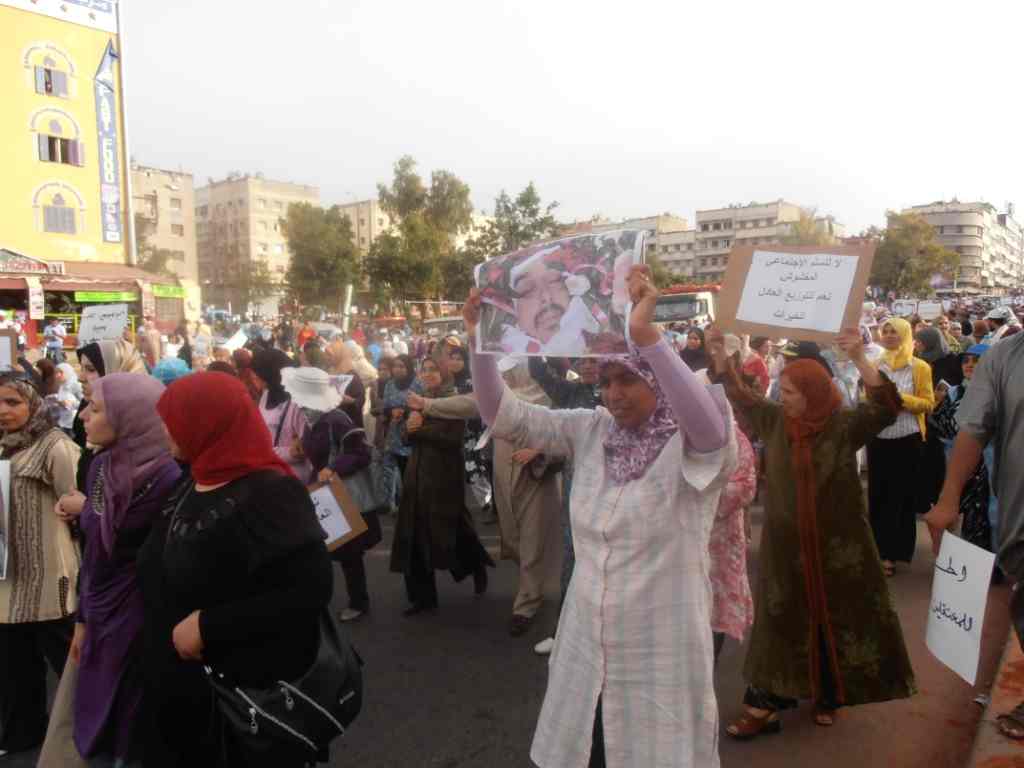
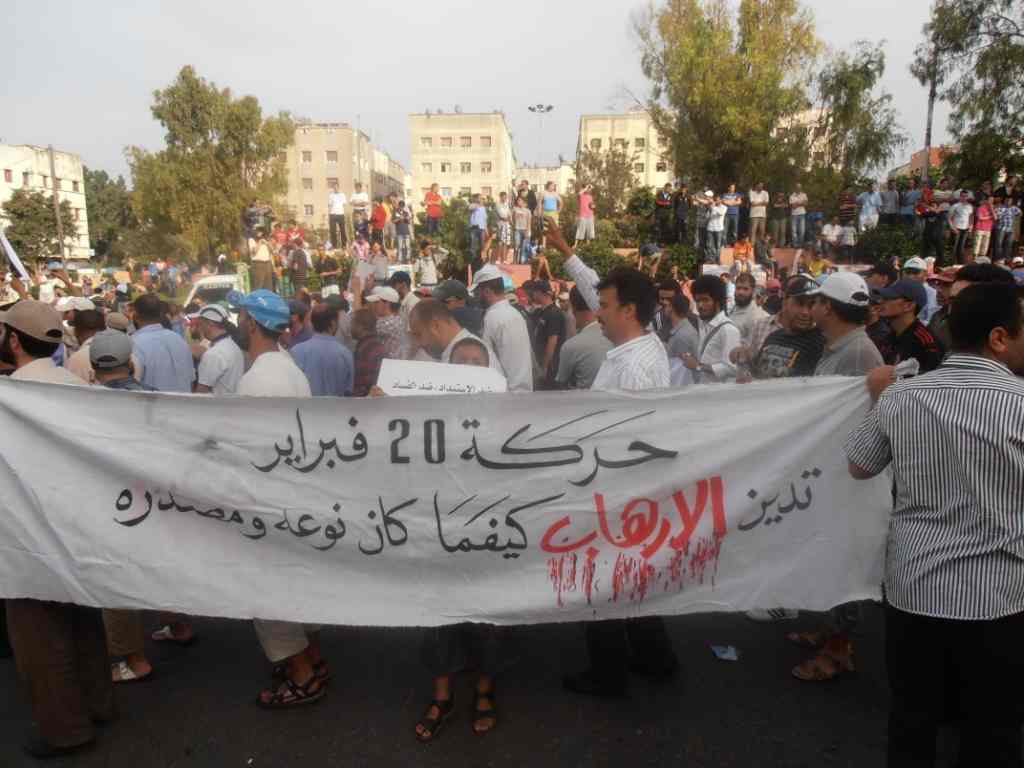
["The February 20th Movement condemns terrorism no matter what kind and from what source.]
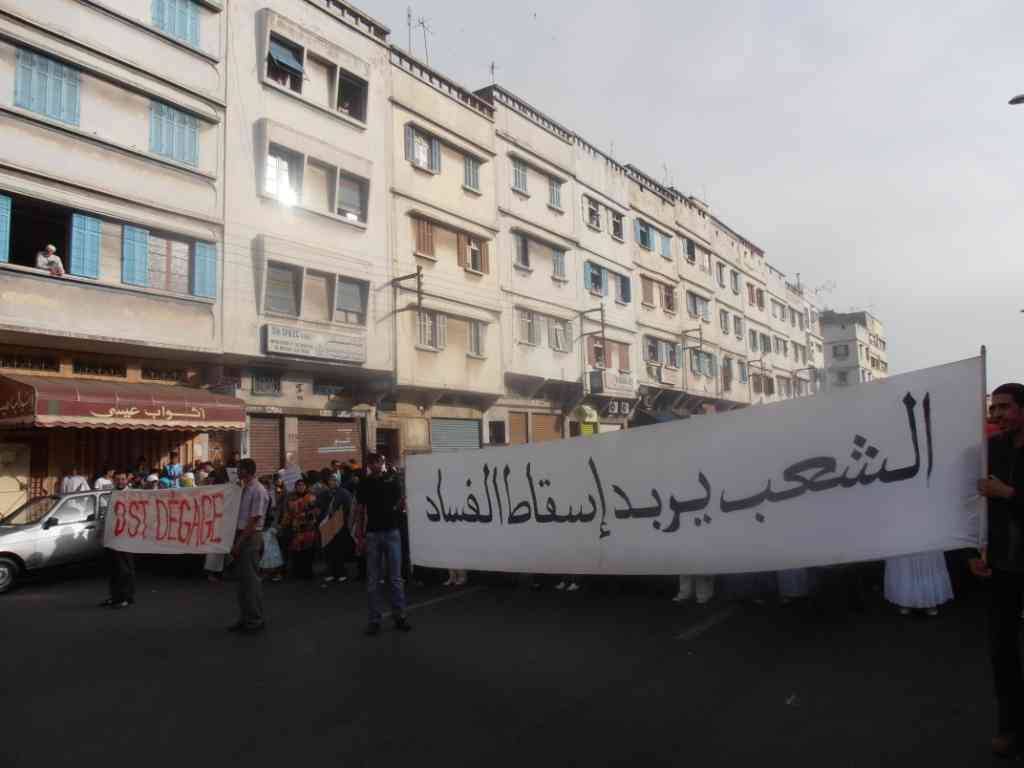
["The people want the fall of corruption.]
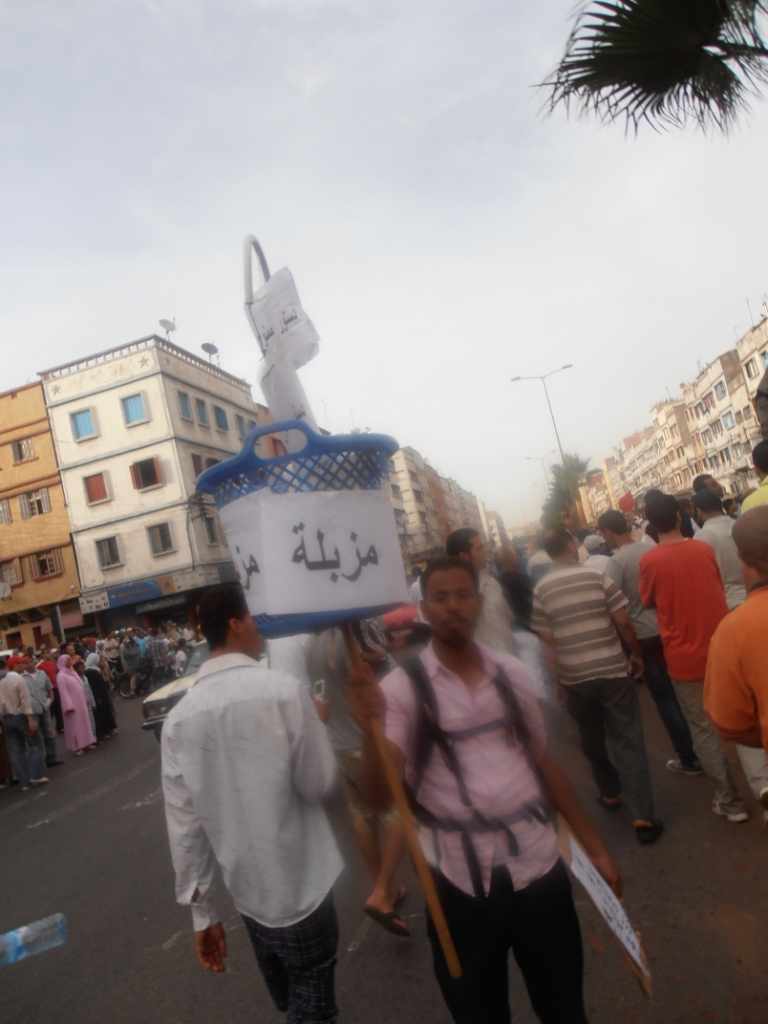
["Garbage."]
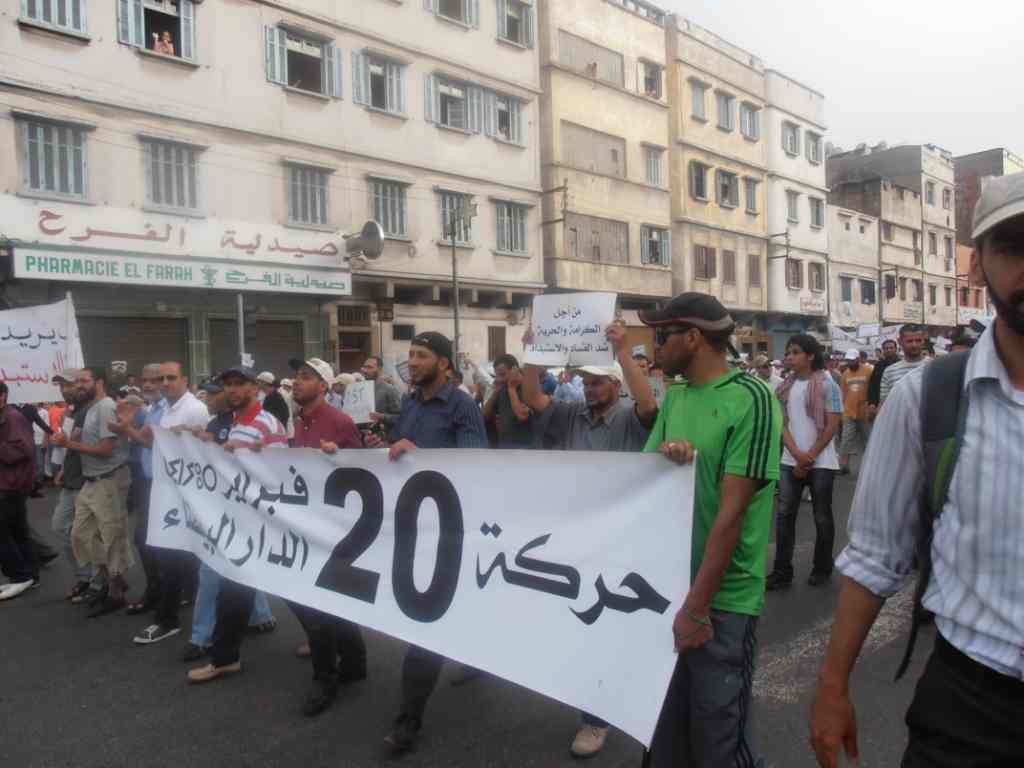
["February 20th Movement - Casablanca"]

["February 20th Movement - The People Want the Fall of Despotism]

["The truth, the whole truth, about the unknown kidnapped"]

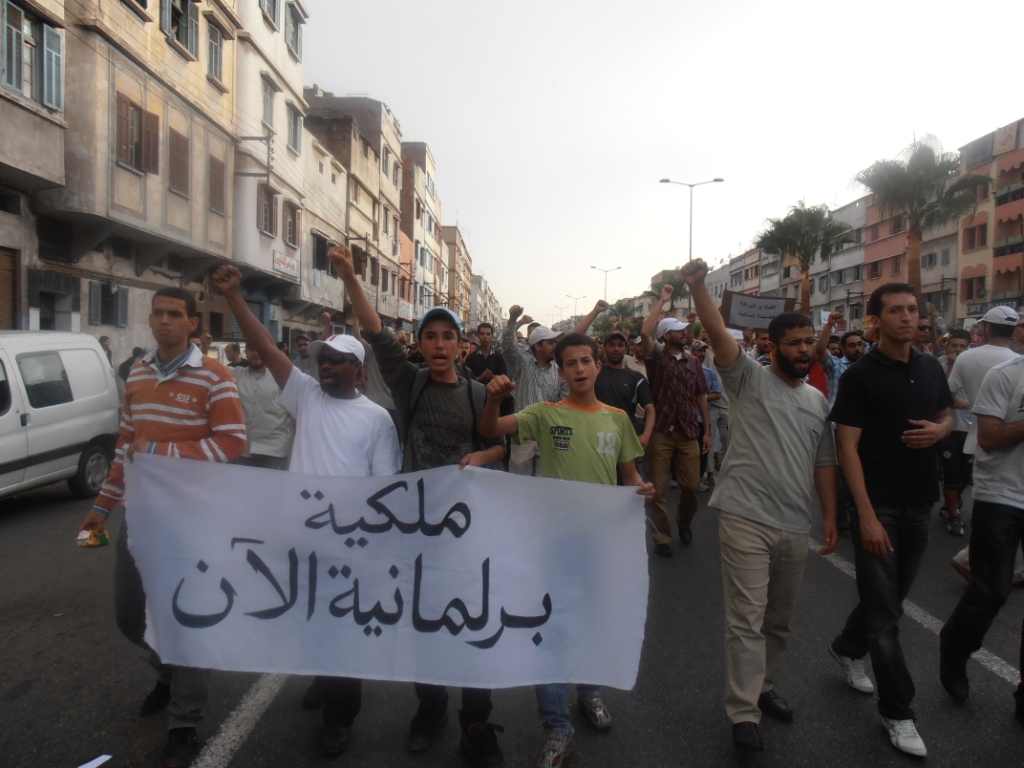
["A parliamentary monarchy now"]